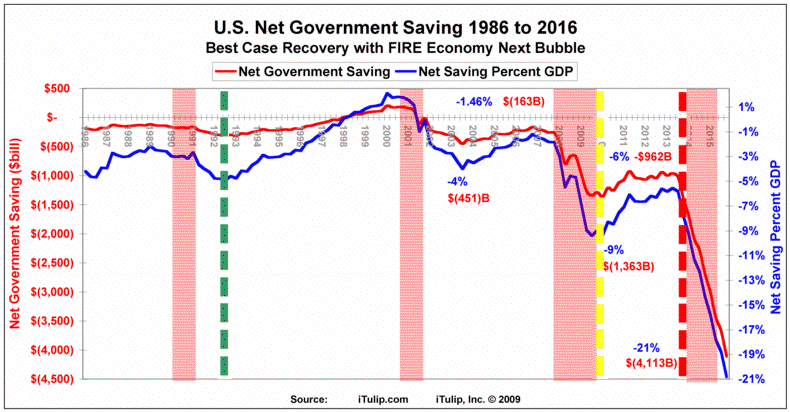http://www.zerohedge.com/article/bra...enfold-or-else
"Out of the $2.22 trillion in expected 2010 issuance, $200 billion will be absorbed by the Fed while QE continues through March. Then the US is on its own: $2.06 trillion will have to find non-Fed originating demand. To sum up: $200 billion in 2009; $2.1 trillion in 2010. Good luck."
"What options does this leave for the administration? Very few, and all of them are ugly. As we stated earlier on, the options for the Fed are threefold:
1)Announce a new iteration of Quantitative Easing. This will be met with major disapproval across all voting classes (at least those whose residential zip codes do not start with 10xxx or 068xx), creating major headaches for Obama and the democrats which are already struggling with collapsing polls.
2)Prepare for a major increase in interest rates. While on the surface this would be very welcome for a Fed that keeps hinting that deflation is the biggest concern for the economy, Bernanke's complete lack of preparation from a monetary standpoint (we are surprised the Fed's $200 million reverse repos have not made the late night comedy circuit yet) to a forced interest rate increase, would likely result in runaway inflation almost overnight. The result would be a huge blow to a still deteriorating economy.
3) Engineer a stock market collapse. Recently investors have, rightfully, realized there is no more risk in equities, not because the assets backing the stockholder equity are actually creating greater cash flow (as we demonstrated recently, that is not the case), but simply because taxpayers have involuntarily become safekeepers for the entire stock market, due to Bernanke's forced intervention in bond and equity markets. Yet the President's Working Group is fully aware that when the time comes to hitting the "reverse" button, it will do so. Will the resultant rush into safe assets be sufficient to generate the needed endogenous demand for Treasuries is unknown. It will likely be correlated to the size of the equity market drop.
If the Fed decides on option three, we fully believe a 30% drop (or greater) in equities is very probable as the new supply/demand regime in fixed income becomes apparent. We hope mainstream media takes the ideas presented here and processes them for broader consumption as indeed the Fed is caught in a very fragile dilemma, and the sooner its hand is pushed, the less disastrous the final outcome for investors. Then again, as Eric Sprott has been pointing out for quite some time, it could very well be that the US economy has become merely one huge Ponzi, and as such, its expansion or reduction on the margin is uncontrollable. We very well may have passed into the stage where blind growth is the only alternative to a complete collapse. We hope that is not the case."
"Out of the $2.22 trillion in expected 2010 issuance, $200 billion will be absorbed by the Fed while QE continues through March. Then the US is on its own: $2.06 trillion will have to find non-Fed originating demand. To sum up: $200 billion in 2009; $2.1 trillion in 2010. Good luck."
"What options does this leave for the administration? Very few, and all of them are ugly. As we stated earlier on, the options for the Fed are threefold:
1)Announce a new iteration of Quantitative Easing. This will be met with major disapproval across all voting classes (at least those whose residential zip codes do not start with 10xxx or 068xx), creating major headaches for Obama and the democrats which are already struggling with collapsing polls.
2)Prepare for a major increase in interest rates. While on the surface this would be very welcome for a Fed that keeps hinting that deflation is the biggest concern for the economy, Bernanke's complete lack of preparation from a monetary standpoint (we are surprised the Fed's $200 million reverse repos have not made the late night comedy circuit yet) to a forced interest rate increase, would likely result in runaway inflation almost overnight. The result would be a huge blow to a still deteriorating economy.
3) Engineer a stock market collapse. Recently investors have, rightfully, realized there is no more risk in equities, not because the assets backing the stockholder equity are actually creating greater cash flow (as we demonstrated recently, that is not the case), but simply because taxpayers have involuntarily become safekeepers for the entire stock market, due to Bernanke's forced intervention in bond and equity markets. Yet the President's Working Group is fully aware that when the time comes to hitting the "reverse" button, it will do so. Will the resultant rush into safe assets be sufficient to generate the needed endogenous demand for Treasuries is unknown. It will likely be correlated to the size of the equity market drop.
If the Fed decides on option three, we fully believe a 30% drop (or greater) in equities is very probable as the new supply/demand regime in fixed income becomes apparent. We hope mainstream media takes the ideas presented here and processes them for broader consumption as indeed the Fed is caught in a very fragile dilemma, and the sooner its hand is pushed, the less disastrous the final outcome for investors. Then again, as Eric Sprott has been pointing out for quite some time, it could very well be that the US economy has become merely one huge Ponzi, and as such, its expansion or reduction on the margin is uncontrollable. We very well may have passed into the stage where blind growth is the only alternative to a complete collapse. We hope that is not the case."


Comment